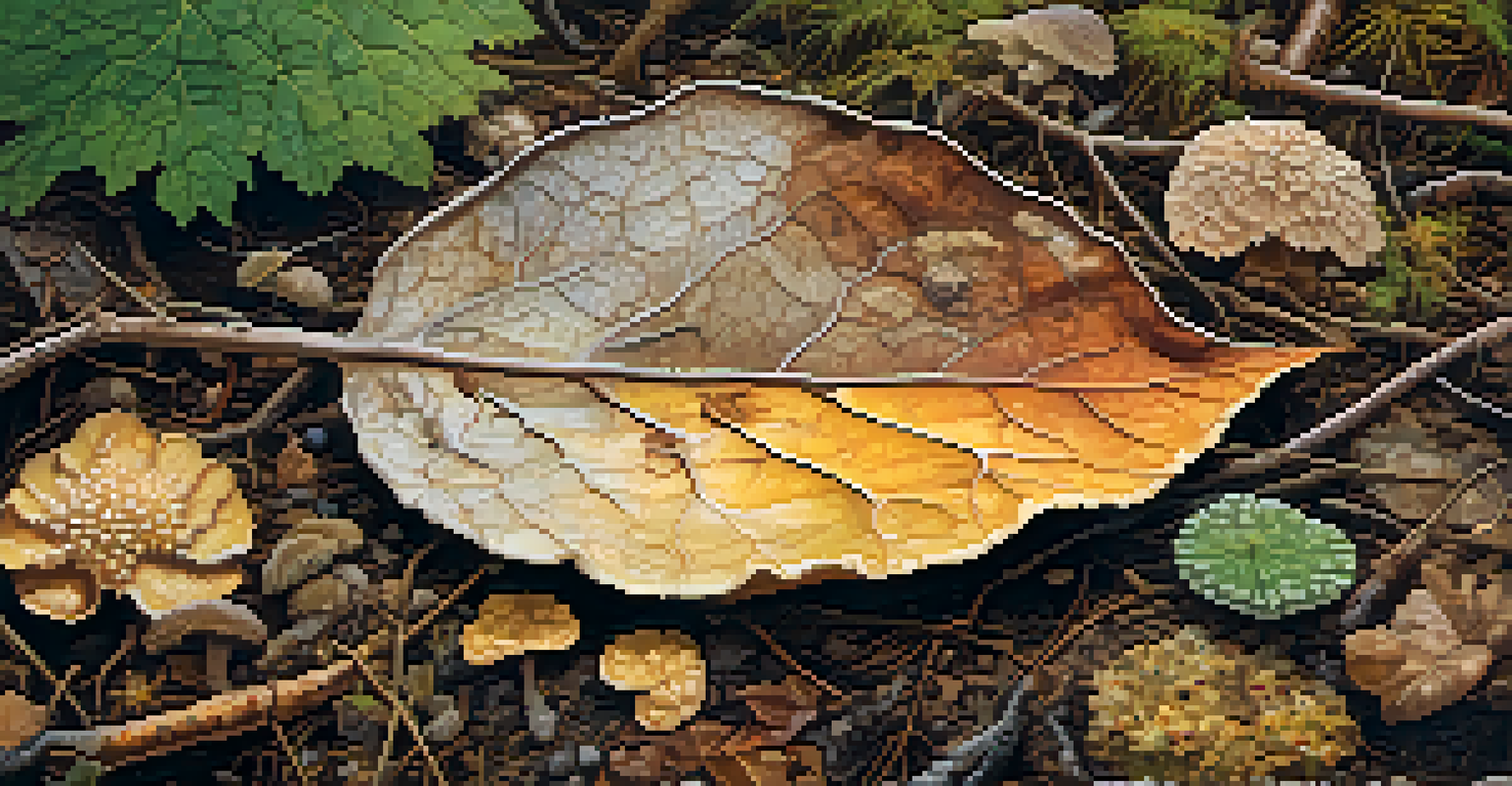The Mutual Benefits of Fungi and Plants in Ecosystem Balance

Introduction to Fungi and Plants in Ecosystem Dynamics
Fungi and plants share a remarkable relationship that is crucial for maintaining ecosystem balance. This partnership is often overlooked, but it plays a vital role in nutrient cycling and soil health. By understanding how these two organisms support each other, we can appreciate the intricacies of nature's web.
The soil is the great connector of our lives, the source and destination of all. Food, fiber, building materials, and even clean water are all dependent on this incredible resource.
Fungi, with their vast underground networks, help plants absorb essential nutrients like phosphorus and nitrogen. In return, plants provide fungi with carbohydrates produced through photosynthesis. This mutual exchange is a prime example of how cooperation drives ecological stability.
Overall, the interplay between fungi and plants not only enhances their survival but also contributes to the health of entire ecosystems. Recognizing this relationship is the first step in promoting biodiversity and fostering sustainable practices.
The Role of Mycorrhizae in Plant Growth
Mycorrhizae are specialized fungi that form symbiotic relationships with plant roots. These fungi extend the root system of plants, increasing their ability to absorb water and nutrients from the soil. This enhanced access to resources can significantly boost plant growth, especially in nutrient-poor environments.

For example, forest trees often rely on mycorrhizal networks to thrive in competition with other plants. These networks can help trees share nutrients, effectively creating a community of interconnected organisms. This mutual benefit not only strengthens individual plants but also promotes the overall health of the forest.
Fungi and Plants: A Vital Partnership
The symbiotic relationship between fungi and plants is essential for nutrient cycling, soil health, and ecosystem stability.
In essence, mycorrhizae act like a support system for plants, allowing them to access resources they might not reach alone. This relationship underlines the importance of preserving healthy soil ecosystems, which are foundational to thriving plant communities.
Fungi's Role in Nutrient Cycling
Fungi play a crucial role in breaking down organic matter, recycling nutrients back into the ecosystem. Decomposing dead plants and animals, fungi convert complex organic materials into simpler forms that plants can absorb. This process is essential for maintaining soil fertility and supporting plant life.
In nature, nothing exists alone.
For instance, when leaves fall to the ground, fungi quickly begin to decompose them, returning nutrients like nitrogen and carbon to the soil. This not only nourishes existing plants but also prepares the ground for new growth, ensuring a continuous cycle of life.
By facilitating nutrient cycling, fungi help sustain diverse ecosystems. This relationship highlights the importance of maintaining fungal populations and their habitats, as their decline could lead to reduced soil health and ultimately, plant death.
Plant Defense Mechanisms Supported by Fungi
Fungi can also enhance plant defenses against pests and diseases. Some mycorrhizal fungi have been shown to improve a plant’s resilience by producing compounds that deter herbivores and pathogens. This can reduce the need for chemical pesticides, promoting a healthier environment.
For example, plants that are well-connected to mycorrhizal networks often exhibit increased tolerance to stressors, including drought and soil-borne diseases. This ability to withstand challenges means that these plants can thrive in less-than-ideal conditions, ensuring their survival and that of surrounding flora.
Mycorrhizae Boost Plant Growth
Mycorrhizal fungi enhance plant growth by extending root systems and improving access to water and nutrients.
This protective role of fungi underscores the necessity of maintaining these relationships in agricultural practices. By fostering healthy fungal populations, farmers can enhance crop resilience and ultimately lead to more sustainable farming methods.
Impact of Climate Change on Fungi-Plant Interactions
Climate change poses a significant threat to the delicate balance between fungi and plants. Changes in temperature and precipitation patterns can disrupt fungal growth, which in turn affects plant health and nutrient uptake. This ripple effect can lead to decreased agricultural yields and compromised ecosystems.
For instance, extreme weather events can lead to soil erosion, diminishing the habitat for beneficial fungi. As these organisms decline, plants may struggle to access the nutrients they need, making them more susceptible to disease and less capable of adapting to environmental changes.
Addressing climate change requires a holistic approach that considers the interconnectedness of all organisms in an ecosystem. By protecting and nurturing the relationships between fungi and plants, we can build resilience against the impacts of climate change.
Human Impact on Fungi and Plant Relationships
Human activities, such as deforestation and industrial agriculture, significantly disrupt the relationships between fungi and plants. These practices can lead to soil degradation, loss of biodiversity, and the decline of fungal species, all of which harm plant health. The result is a weakened ecosystem that struggles to sustain itself.
For example, the overuse of fertilizers may temporarily boost plant growth, but it can also harm beneficial fungal populations in the soil. This creates a dependency on chemical inputs and diminishes the natural resilience of plant communities, leading to a cycle of degradation.
Climate Change Threatens Ecosystems
Climate change disrupts the delicate interactions between fungi and plants, which can lead to reduced agricultural yields and weakened ecosystems.
By adopting more sustainable land-use practices, such as agroecology and reforestation, we can help restore these vital relationships. This not only benefits plants and fungi but also promotes overall ecosystem health and biodiversity.
Conservation Efforts for Fungi and Plants
Conservation efforts are essential for protecting the mutualistic relationships between fungi and plants. Initiatives such as habitat restoration, sustainable agriculture, and biodiversity preservation can help ensure that both groups thrive. By safeguarding their environments, we support the complex web of life that sustains our ecosystems.
For instance, creating protected areas that allow natural ecosystems to flourish can provide a refuge for both fungi and plants. This can enhance their interactions and promote resilience against environmental changes.

Ultimately, prioritizing conservation not only preserves these relationships but also fosters a healthier planet for future generations. By recognizing the importance of fungi and plants in ecosystem balance, we can take meaningful steps toward sustainable coexistence.